Now that we have an understanding of how to interpret UDT results, it is important to understand how to act on the full spectrum of concerns…
UDT results will fall along a spectrum ranging from expected, to mild aberrancy, to major aberrancy. There is also an axis for level of certainty in the result – from low level of certainty (high potential for false positive or false negative) to high level of certainty. This wide range of results must then be applied to a wide range of patients who will have innumerable other unique factors that contribute to the overall clinical Gestalt. You can see that there are an infinite number of scenarios so memorizing approaches without a deeper understanding of what we are doing is not possible. Understanding the big picture when applying UDT results is critical. UDT is meant to contribute to the clinical Gestalt, as we weigh the risks and benefits of prescribing opioids. It is not meant to be a replacement for clinical Gestalt.
By understanding the important factors that suggest someone is being helped or harmed by opioids, we can make more informed decisions about if/how we prescribe them.
The decision about if and how to prescribe opioids essentially comes down to weighing risks against benefits. The Clinical Gestalt will fall along a spectrum ranging from Benefits>>Risks, to Risks>>Benefits. When we first start someone in HARMS, we are estimating which scale is most representative of this patient. When new information such as UDT results come in, the scales may tip and the risk category changes. This chapter will primarily cover what factors we should consider when assessing where a patient falls and how we should adjust the balance based on new information (such as UDT results).
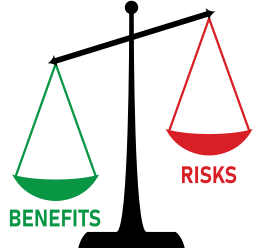
Benefits>>Risks
Low Risk - infrequent UDT, longer dispensing intervals.
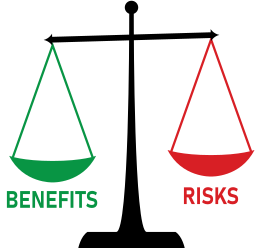
Benefits~Risks
High risk - consider alternative treatment options - if continuing to prescribe opioids then very short intervals, frequent UDT.
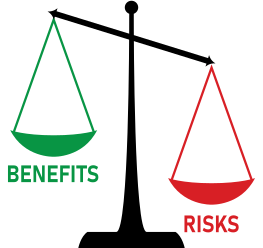
Risks>>Benefits
Taper and stop (or if OUD is identified, rotate on to OAT).
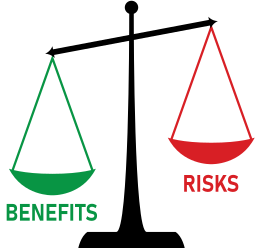
Benefits>Risks
Medium Risk - infrequent UDT, shorter dispensing intervals.

Risks>Benefits
Patient should probably have opioids tapered and stopped (unless opioid addiction is identified in which case you would rotate to OAT).
However, if you decide to keep prescribing opioids for “pain” in this patient then you may consider a hybrid between opioids for pain and opioids for addiction in which you have daily dispensing and frequent UDT (we call this the “structured” stream).
The only challenge is that if truly treating pain then you generally would be using TID-QID dosing, whereas OAT is typically OD dosing. While both would have daily observed dosing at the pharmacy, the “pain” patient would typically get take-home doses (or multiple observed doses at the pharmacy). You will have to use clinical judgement about take-home doses or consider using 24hr-release morphine formulations if comfortable.
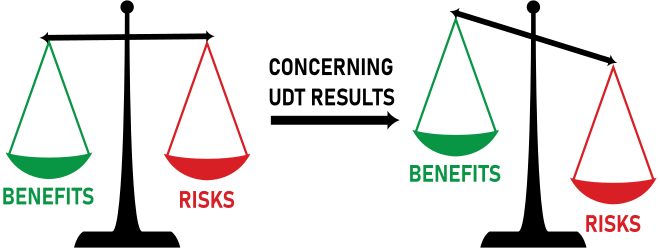
To illustrate how the scale will tip based on new information, imagine a patient that is high risk has new and concerning UDT results. You can see how the risks side becomes heavier, and now our overall risk/benefit assessment has shifted. We must therefore adapt our prescribing/monitoring approach to this new information, and evolving risk category.
So if the decision of if/how to prescribe opioids – and how to adapt to new information – comes down to weighing the risks/benefits, what types of factors contribute towards this risk/benefit balance?
- Function
- Engagement in hobbies/activities
- Social stability (work, relationships, housing, etc)
- Day-to-day function (7 categories within BPI1)
- General activity
- Mood
- Walking ability
- Normal work (including work outside the home and housework)
- Relations with other people
- Sleep
- Enjoyment of life
- Pain - this is inherently subjective so unfortunately has limitations, however it should be considered
Markers of Risk from opioids may include:
- Signs of opioid use disorder
- Side effects of opioids
- Poor pain diagnosis
- UDT result
- Risk Factors for Opioid misuse/abuse (see Chapter 2)
- History of substance use disorder
- History of mental health diagnosis
- Opioid prescription characteristics
- Higher doses (> 90mg morphine equivalent/day recommended as one watchful dose2)
- Demographic factors:
- Younger age
- Male sex
- Family history of substance use disorder
- History of sexual abuse in females
- Red Flag Behaviours (See Appendix V)
- Selling prescriptions or prescription forgery
- Obtaining opioids from nonmedical sources (ie. purchasing street drugs, stealing/borrowing from family/friends)
- Double doctoring (seeking medications from other clinicians or ER)
- Altering oral formulations (injecting, biting or crushing)
- Concurrent abuse of alcohol or illicit drugs
- Multiple dose escalations or other noncompliance
- Early refills
- Multiple episodes of prescription “losses”
- Deteriorating function (ie. work, family, socially)
- Resistance to therapy changes despite clear evidence of side effects (adverse physical or psychological)
We use our clinical judgement to essentially plop these weights (and any others you can think of that aren’t listed here) onto a scale as we form a clinical Gestalt.
For example, if someone has significant benefits from opioids and since starting them is now working for the first time in a decade, then this is a “heavy” weight towards the benefits side. Even if that person has a history of substance use disorder (a weight on the risk side), assuming other factors are non-contributory, benefits outweigh risks at this point in time. Note that a formalized scoring system is not used here. We use our clinical judgement.
Given that the risk/benefit balance can fall along a spectrum, it is important that our approach to prescribing and monitoring opioids can match this spectrum. To put it explicitly, it’s not a matter of simply deciding to prescribe or discontinue the opioid. There are middle-ground options where we can tighten control without necessarily discontinuing the medication. For example, with a higher risk patient in whom benefits still may outweigh risks, short dispensing interval and more frequent UDT leads to tighter control. With lower risk patients, longer intervals and less frequent UDT. This is all captured in the HARMS Program Risk Ladder. The Risk Ladder guides not only how to tailor UDT frequency to patient’s initial estimated risk, but perhaps more importantly, it guides how to adapt our monitoring/prescribing to the full spectrum of UDT results.
While the Risk Ladder was designed to guide how we adapt our prescribing/monitoring to UDT results, the same principles discussed here can be applied to any factor that shifts the risk/benefit balance. For example, if someone has decreasing social stability or recurrent early refills, then that would add a weight to the “risk” side of the scale and may be a reason to move up the Risk Ladder. If someone has a new stable relationship and depression is in remission (benefits have gone up, and risks have gone down), then that may be reason to move someone down the ladder.
Now that we’ve covered the “big picture”, let’s look specifically at how we respond to UDT results. This is one of the main obstacles to applying UDT in clinical practice – we often struggle with how to act on the results. There are minor concerns on UDT and/or likelihoods of a false positive/negative, and at the other end of the spectrum are major concerns that are essentially 100% accurate (a drug is detected on LC-MS that is not a metabolite, or potential pharmaceutical contaminant, of a prescribed medication). It is for this reason – UDT results having a spectrum of concern from minor to major – that our response to UDT results should also fall along a spectrum. This is where the HARMS Program Risk Ladder becomes particularly valuable. To reiterate – while it is used to guide how we prescribe and monitor based on a patient’s initial risk estimate, it’s main value comes in guiding how we respond to UDT results. An additional benefit is that it can be applied to not only the UDT results, but any clinical concern (new behavioural observations, social instability, etc.)
The general aim of the Risk Ladder is to balance safety and patient convenience. If someone is low risk, then there is no need to inconvenience them through frequent UDT and short dispensing intervals (these interventions would have little to no safety benefits for someone who is low risk). Likewise, if someone is higher risk, then these increased safety concerns justify tighter control (at the expense of patient convenience) with more frequent monitoring (UDT), and smaller amounts of opioid dispensed at a time. Remember that balance is central to the HARMS Program. In the case of the Risk Ladder, we are trying to balance patient safety and convenience.
The Risk Ladder assumes that everyone – even the lowest risk patient – has some risk and therefore is subjected to universal precautions with UDT. If the universal monitoring with UDT detects a concern, then control is tightened. The process is dynamic – with initial risk estimate guiding the frequency of monitoring, and monitoring results in-turn guiding risk level, then refined risk level adjusting further monitoring frequency, and so on in an iterative process. A minor/soft concern may lead to increased monitoring, and if this concern grows then monitoring and prescribing will get tighter and tighter. This iterative process aims to hone in on the best estimate of risk/benefit balance.
If the clinical Gestalt (from UDT or otherwise) means that the risk category should be shifted, then – in addition to discussing with the patient – the physician should notify the clinical administrator who maintains the master list so that it can be updated.
Cases

Case 1
56 year old male labourer on oxycodone/acetaminophen 120 tabs q30d for knee pain for over five years. He presents saying his knee pain is worse with a change in his job, and he’s going to be out of his Percocet tomorrow (9 days early). This is his first early refill request and you have no other concerns. What should you do?
Although this result does not include a UDT result, it is helpful to think about movement on the ladder in response to any clinical concern (UDT or otherwise). In this case, a first early-refill request with a good explanation, in someone who otherwise is clinically stable, would likely be considered a “minor” concern. Depending on your Gestalt, and your practice style, there are likely 3 options for this patient: i) the most “severe” might be to consider moving him up one rung (ie: shorten his interval). It likely isn’t justified moving him up more than one rung unless there are other concerns. ii) intermediate concern - if you think the concern is so minor that no movement on the ladder is justified, but “something” should be done to avoid it happening again - consider a middle-ground of a “notice”. You can think of this like a “strike”, although that word may be too pejorative. You may say something to the effect of: “We can do an early refill this time. However I’m going to put a note on your file and if you have another early refill request then we will have to shorten your interval.” We’ve found this very effective - it’s serving as going up half a rung. iii) If you are not at all concerned, then you may oblige his request with no movement on the ladder and no “notice”, but be careful if this becomes recurrent and re-evaluate if more requests come in.
Case 2
a. 35 year old female has been transferred to your practice on oxycodone/acetaminophen 4 tabs/day. She has a 2 year history of opioid use for back pain since a motor vehicle accident. She has a history of depression and alcohol use disorder (in sustained remission) and has been working as a personal support worker at the local hospital for the last year. How would you risk stratify her initially based on the limited information you have?
While you would almost certainly do a complete history and physical, and review old records, and consider a baseline UDT, for the sake of this case let’s say that you stratify her as Medium Risk (Level 3) because she has concerns on history (Depression, EtOH Use Disorder) but appears to be doing well right now (working, abstinent of EtOH).

- Risks
- Hx of Depression (remission)
- EtOH Use Disorder (remission)
- Benefits
- Employment
- Pain self-reports
b. She goes on to have one early refill with an episode of increased pain. She begins taking increased time off of work, and no-showed for her UDT. She finally presents to the office for a UDT and the IA is positive for cocaine and oxycodone. She also acknowledges that she has relapsed with her EtOH Use Disorder. What do you do?
This is a complicated scenario but highly realistic. Note that there are numerous factors here contributing to her risk/benefit balance. Again, memorization of cases is not helpful - what is helpful is to think of the big picture. If we were to plot her story on a risk/benefit scale, this is what is happening:

- Risks
- EtOH Use Disorder (active)
- Hx of depression
- Non-compliance with clinic appointments
- Early refills
- Job instability
- Cocaine use on UDT
- Benefits
- Pain self-reports
Note how we can apply this approach to any patient, with any constellation of symptoms/history/UDT results, etc. In this case, her risk has most certainly changed and you will have to use your clinical judgement to decide if you continue to prescribe opioids long-term (vs tapering and stopping), and if so, how tightly you would like to prescribe and monitor. An open, non-judgemental discussion with the patient is always crucial. As a side note, remember that cocaine on IA has ~100% specificity so the risk of a false positive is essentially zero. You therefore could discuss prior to the LC-MS result coming back. The concerns identified in this patient likely justify going at least to Level 4, if not 5, or even to taper and stop opioid medications.
Case 3
45 year old male with chronic pain and a past history of EtOH Use DIsorder. He was initially a risk Level 3 due to his history but has been on a stable dose of morphine for the past 2.5 years, working regularly at a retail store, and in a stable relationship. He has regularly presented for UDT with negative results and has developed trust with his primary care provider with moves down the risk ladder to Level 1 (longer intervals between dispensing and less frequent UDT).
Remember that every situation can be approached by thinking about the risks and benefits, and how much weight they carry. Again, memorization of cases is not helpful - what is helpful is to think of the big picture. If we were to plot his story on a risk/benefit scale, this is what is happening:

- Risks
- Hx of EtOH Use Disorder
- Benefits
- Stable Employment
- Stable Relationship
- Absence of behavioural concerns
Today’s IA UDT was positive for morphine and oxycodone. Patient self-reported the oxycodone and says that his pain was so bad on the weekend that he got some off of a friend. What should you do?

- Risks
- Hx of EtOH Use Disorder
- Aberrant UDT Result
- Benefits
- Large weight for working
- Large weight for stable relationship
Note that this is likely not reason to taper and stop his medications, but there has been a shift in the risk/benefit balance and you should probably increase his Risk Level (2 or 3 would seem appropriate, at your discretion and taking into account his honesty, your relationship with him, etc.). If he goes on to lose his job, and his stable relationship, then you can see how the scale will continue to tilt and your approach will have to continue to adapt to the new information. Remember that all we are doing is incorporating the information we have (UDT and innumerable others that constitute the clinical picture of the person) into a risk/benefit assessment and prescribing and monitoring according to that assessment.
Chapter Pearls

- UDT is only one piece of the clinical picture. It should complement the rest of the clinical picture when making decisions about how to act on results. Any piece of i nformation that contributes to your overall risk/benefit assessment can be used.
- Consider using a clinical approach like the HARMS Program Risk Ladder when acting on UDT results. If a UDT result is concerning - or there are behaviour concerns such as recurrent early refills, lost prescriptions etc. - then movement up the ladder should be in proportion to degree of concern. A high degree of concern means significant movement up the ladder (if not off of the ladder completely), whereas a minor concern may mean going up one rung.
REFERENCES:
- Cleeland C S. The Brief Pain Inventory. 1991. https://www.mdanderson.org/documents/Departments-and-Divisions/Symptom-Research/BPI-Long_English_SAMPLE.pdf. Accessed August 19, 2019
- Busse J. The 2017 Canadian Guideline for Opioids for Chronic Non-Cancer Pain. 2017.
With the core aspects of the HARMS Program covered, the appendices go into more depth about various areas that may warrant further clarification…
